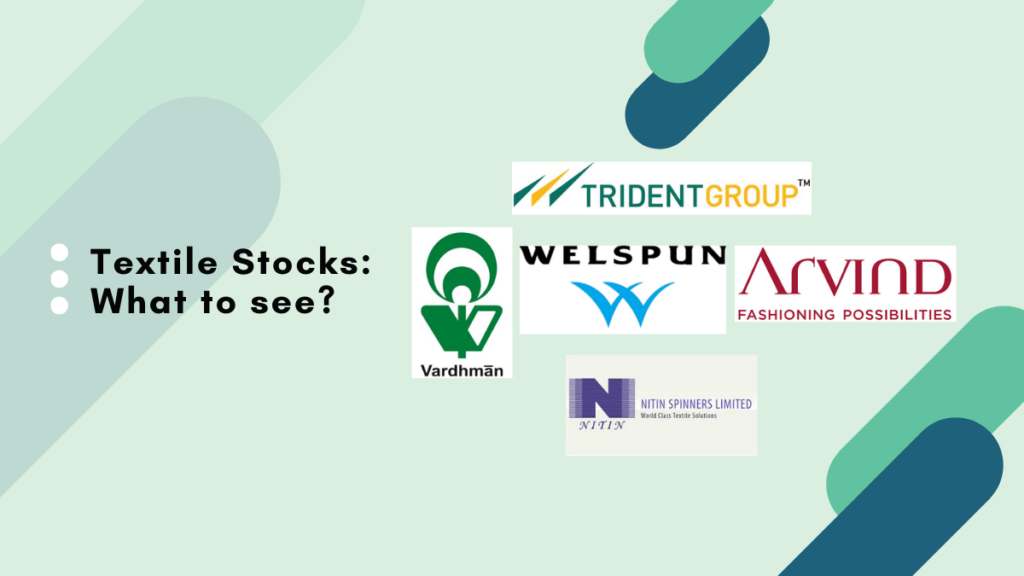The Textile industry in India is one of the largest in the world with a large Raw Material base and Manufacturing strength across the value chain. Indian Textile Industry traditionally, after Agriculture, is the only Industry that has generated huge employment for both skilled and unskilled labour. It is also the second-largest employment generating sector in India.
India is:
- World’s second largest producer of Textiles and Garments.
- Largest producer of Cotton in the World.
- Also, Second largest producer of Fibre in the world and the major Fibre produced is Cotton.
- Moreover, Second largest exporter of Cotton in the World.
- Leading consumer of Cotton.
- Second largest producer of Silk in the World.
Top things to analyze before investing decision in
textile stocks:
(A) Key Operational Parameters
(i) Production
Production as well as Production capacity is one of the important aspects of analyzing Textile Industry. Total Production Capacity and Production of the Industry has to match the prevailing Demand of the Textile Products. If the Demand is higher than the Capacity, then the Industry will not be able to Supply the customers without extensive capacity addition. Therefore, the companies require heavy capital expenditure.
On the other hand, if Capacity is higher than the Demand, then it will have lots of idle Workers and Machines, which is not good either.

* F.Y. 2019-20 – Yarn Production until January 2020.
The fundamental strength of the Textile Industry in India is its strong Production base of wide range of Fiber/Yarns from Natural Fibers like Cotton, Jute, Silk and Wool as well as Synthetic/Man-made Fibers like Polyester, Viscose, Nylon and Acrylic.
In addition, Textile Industry of India contributes about 7% to the Country’s Total Manufacturing Production and 2.3% to the GDP of India.
(ii) Growth Drivers for Textile Industry

(iii) Current Growth Factors for rising Textile Industry Demand
- The Home Textile industry witnessed a strong demand revival during 2QFY21 on high demand from big retailers (selling essentials), who saw their inventory pipeline running dry due to a demand recovery, lower channel inventory, and precautionary buying by big retailers during the COVID-19 pandemic.
- Increasing geopolitical tensions between the US and China and global companies. Because of the growing preference for India as a potential supplier, domestic textile players are seeing significant market share gains from China.
- Weak INR is supporting Indian exporters: The USD:INR is depreciating at a faster pace than the USD:RMB (official currency of China), which made Indian exporters competitive v/s the Chinese. From Jan-Oct’20, the USD:INR depreciated by 4% to 74.11/USD. On the contrary, the USD:RMB appreciated by 3% to 6.69/USD.
(iv) Indian Textile Industry is a key exporter
- Export have been a core feature of India’s Textile and Apparel Sector.
- Indian Textile Industry is the 5th largest Exporter of Textiles and Apparel.
- In fact, it contributes 13% to the Country’s Export Earnings
- Also, India is the world’s second-largest textile exporter. Capacity built over years led to low cost of production per unit in India’s textile industry. Thus, this lent a strong competitive advantage to country’s textile exporters over key global peers.
- Moreover, the strong performance of Textile Export is reflected in the value of export from the sector over these years. Textile export increased to US$ 38.70 billion in FY19 at a CAGR of 4.22% over FY16. Moreover, it reached US$ 22.94 billion in FY20.
- Also, exports of Readymade Garments (of all textiles) was worth US$ 1.19 billion as of December 2020.
- In addition to above, from F.Y. 2015-16 to F.Y. 2018-19, Textile and Clothing Export grew at a CAGR of 4.22%.
Rise in the Demand of Exports also increases the Demand of Indian Textile Products outside India.
(B) Key Financial Parameters
Also check these important performance parameters of Vardhman Textiles Ltd.
(i) ROE(%)
One of the most important Profitability Metrics is Return on Equity for any Industry or Company. Return On Equity (ROE) is the amount of Net Income generated by an Industry/company as a percentage of its Shareholder’s Equity. Most importantly, it measures profitability by showing how much Net Profit an Industry can generate with the Money invested from shareholders.
In other words, ROE helps in measuring an Industry’s proficiency to generate Profit from its Shareholder’ Investments.

An Industry that could produce a high as well as consistent ROE over time is like a Money Compounding Machine. Higher the ROE is, the larger the compounding effect, and as a Result, the wealthier its Shareholders are.
(ii) ROCE(%)
Return On Capital Employed is a Financial Ratio that can be used to assess an Industry’s Profitability and Capital Efficiency. ROCE helps understand how efficiently an Industry is using its Total Capital to generate Profits.
ROCE is highly useful Parameter in the Industries like Textile Industry that require massive amounts of Capital Expenditure. Because this industry does huge capital expenditures, efficient use of capital is a major strength that can make an Industry a preferred opportunity for Investors.

(iii) EBITDA Margin (%)
EBITDA Margin is a useful measure of an Industry’s performance. It evaluates the Financial Health of an Industry. That is because it suggests how much cash an Industry can generate.
Therefore, a high EBITDA percentage denotes a robust and well-managed Cash Flow and low Operational Expenses.

(iv) Asset Turnover (x)
Asset Turnover Ratio measures the efficiency of an Industry. It measures an Industry’s ability to generate Sales from its Assets by comparing Net Sales with Total Assets.
The higher the Asset Turnover Ratio, the more efficient an Industry is at generating Revenue from its assets. on the other hand, if an Industry has a low Asset Turnover Ratio, it indicates it is not efficiently using its Assets to generate Sales.

(v) Receivable Days
This Ratio is important as is used to quantify an Industry’s effectiveness in collecting the money owed by customers or clients.
In other words, It shows the number of days an Industry takes to collect cash from its credit sales. The trend of receivable days how well it is in collecting cash from its customers and whether the Industry is efficient or not in keeping the number of days in check.

(vi) Inventory Days
Inventory Turnover measures how many times in a given period an Industry is able to replace the inventories that it has sold. In other words, it is a measurement of the average number of days or time required for a business to convert its Inventory into sales.
A low Inventory Days indicates that an Industry is able to more quickly turn its inventory into Sales and there is considerable demand for its Products. On the other hand, very high Inventory indicate weaker Sales and declining demand for the Industry’s Products.

(C) Other Key Comparative Parameters
(i) Cost
(a) Cost of Raw Mateial
Cotton, Jute, Silk and Wool are key Raw Materials for the Textiles Industry. Thus, any fluctuation in the prices of these Raw materials affect the Cost of Raw Material Consumed by the Textiles Industry Players.

Cotton Prices – Key raw material & cost component
Cotton prices have been volatile over the past few years.

Prices of Cotton Yarn have increased sharply in India since the beginning of this year in view of a surge in Cotton Prices, besides Domestic and Export Demand. Recently, Cotton Prices have been at an elevated level.

According to Trading Economics Website, Cotton price gained over 13% since the beginning of 2021, with Prices rising nearly 10% in February. Industry estimates suggest that World Cotton Output in the Cotton Season 2021 can be lower by 5%-8% which is 50 million Bales, which may further lead to increase in Prices of Cotton going ahead.
(b) Employee Cost
Indian Textile Industry is the pool of a large young trained Workforce. The Textiles Industry in India is the Second-largest Employer in the country providing direct employment to 45 million people and 60 million people in allied industries.
Skilled Manpower play a key role in the development of a Textile Company, both in Day-to-day Activities and long-term Objectives. Thus, the Success of a Textile Company quite a lot depends on its efficient and effective Manpower and Employees.
Employee Cost is the sum of all wages paid to Employees, as well as the Cost of Employee Benefits paid by the company to its employees.

(ii) Earnings – PBIDTM (%)
The PBIDT Margin measures a Company’s Operating Profit as a percentage of its Revenue, revealing how much Operating Cash is generated for each Rupee of Revenue earned.
Its is an important parameter to compare different companies of an Industry. Therefore, a high PBIDT percentage means that the Company has less Operating Expenses, and Higher Earnings, which shows that it can pay all operating costs and still have a good amount of Revenue left over.

Conclusion
Textile industry is highly cyclical in nature with raw material fluctuations as well as various demand fluctuations. Moreover, in order to meet the rising demand, capacity expansion requires heavy capital expenditure. Therefore, capital intensiveness of the industry makes margins & returns shallow.
Thus, a close is watch is required on the capacity expansion plans of the textile players as well as the ability to expand margins.
To know more about textile stocks, connect with us on whatsapp/call at 9988275566.


Drop us your query at – info@pawealth.in or Visit pawealth.in
References: Annual Reports, News Publications, Investor Presentations, Corporate Announcements, Management Discussions, Analyst Meets & Management Interviews, Industry’s Publications.
Disclaimer: The report only represents personal opinions and views of the author. No part of the report should be considered as recommendation for buying/selling any stock. Thus, the report & references mentioned are only for the information of the readers about the industry stated.




Pl let me know about Larsen & turbo information technology
Hi, Thank you for reading our stock research blogs. We uploaded some time back article on L&T infotecj – https://blog.pawealthadvisors.com/2020/06/04/lt-infotech-digital-business-growth-story/
You can go through it.
For connecting with us, Call/WhatsApp – 9988275566